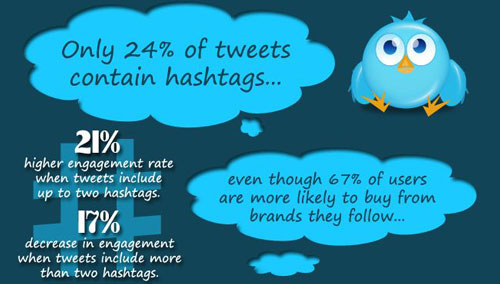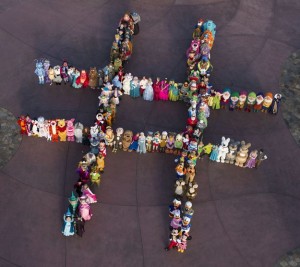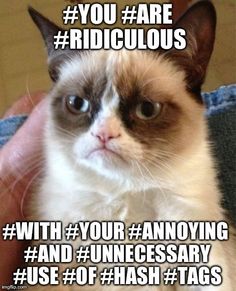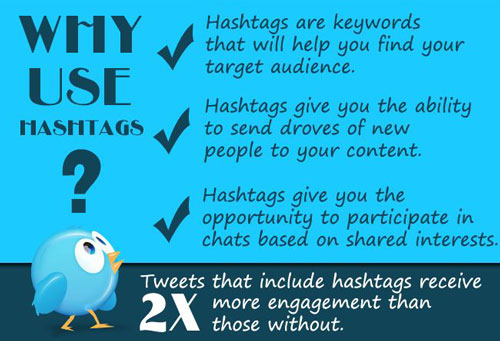How do I Use Hashtags?

This is a “Beginner’s Guide” to #HASHTAGS.
With this guide, you’ll be using hashtags like a pro in no time!
Hashtags have been around a while, and aren’t going to be going away anytime soon. It’s increasingly important to choose the hashtags that will help display your brand in front of your desired audience. Have you incorporated a hashtag strategy into your SEO campaign? Visit our blog How Do #Hashtags Affect My #SEO? to earn more about.
Supported Characters
Which characters can you include in a #hashtag?
For starters, spaces are an absolute no-no. Even if your tag contains multiple words, group them all. If you want to differentiate between words, use capitals instead (#WalkingDead). Uppercase letters will not alter your search results, so searching for #WalkingDead will yield the same results as #walkingdead.
Numbers are supported, so tweet about #50ShadesOfGrey to your heart’s content. However, punctuation marks will not yield results, so commas, periods, exclamation points, question marks, and apostrophes. Forget about asterisks, ampersands, or any other special characters.
Do’s and Don’ts
Caps+lowercase no punctuation marks (, . ! ? ‘ * { [ – )
All caps
All lower case
Keep in mind that the @ symbol does something completely different. Using @ before a person’s Twitter handle will tweet at him directly, letting him know you have written to him via the @Connect tab. A hashtag will not. Sometimes users will tag a celebrity’s name instead of using her Twitter handle — it is acceptable to tweet #Lorde or @lordemusic. However, if you are trying to reach someone directly, don’t use a hashtag.
There is no preset list of hashtags. Create a brand new hashtag by putting the hash before a series of words if it hasn’t been used before, voilà! You’ve invented a hashtag.
Supported Platforms

Most major social media platforms support hashtags. These include:
Twitter: Twitter is the birthplace of modern hashtag usage — as such, its hashtags are more versatile than other sites’ (see “Tone & Voice,” below). Twitter hashtags are mainly used to denote specific topics of conversation. The “Trends” sidebar of your Twitter feed curates a list of hashtags you might be interested in, based on your tweets.
You can now search for a hashtag on Twitter, Facebook, and even Google. When you search for a hashtag on Twitter, there are three ways to filter the results. The “Top” option displays the most relevant and popular posts, including those from users you don’t follow. “All” shows you every tweet that uses the specific hashtag in real-time, and “People you follow” will only display results from the users you are following.
Social Platforms using hashtags
Facebook: Facebook added hashtag support in June 2013, and the practice has not picked up much steam. Nevertheless, clicking on Facebook hashtags will take you to a list of posts containing the same tag. The results are not limited to people you know.
Instagram: Hashtags can be used to complement photos shared on Instagram and help you discover new accounts and pick up followers. Some tags were created specifically for Instagram photo challenges — #ThrowbackThursday, for example, encourages users to post retro photos.
Vine: Vine uses hashtags in the same way — try accompanying each of your Vine videos with at least one tag to maximize share-ability.
Google+: When you click on a hashtag in Google+, the search results will include the original hashtag as well as posts with similar tags and keywords. Google search results display on the left side of the page, while tag results from within Google+ appear on the right. The results from Google also gives you the option to search on Facebook or Twitter.
Tumblr: Tumblr posts have a special “Tag” section where you can enter tags. These tags function like Twitter hashtags, organizing posts by topic, but the hash symbol inserts automatically. Hashtags included in the main body of a post are not transformed into links.
Pinterest: Use Pinterest hashtags to mark and search for content. Click on the hashtag in a pin description to navigate results that contain the exact tag, plus pins with the same word or phrase in the description.
Curious which hashtags are trending across social media? Hashtags.org tells you which tags are hot in real-time. For a list of the most used hashtags on Instagram, click on this link:The 99 Most Used Instagram Hashtags & Their Meanings
Tone and Voice
Beyond simply organizing your tweets, Twitter hashtags can help you craft your voice while joining in a broader discussion. You can use multiple tags in one tweet, but don’t go overboard. One to three is generally an acceptable range.
In a post for The New Yorker, Susan Orlean points out that hashtags can provide colorful commentary as a sort of “muttered into a handkerchief” aside, to give context and to convey humor or sarcasm.
Sometimes a hashtag is so zany or specific that there are few if any, search results attached to it. These exist mainly for entertainment purposes. It adds a dash of humor that followers appreciate.

Here are some sample tweets that use hashtags to add context, humor, and voice:
- Let the weekend begin! #TGIF
- Wearing socks with Crocs is stylish #kidding
- Just dropped my second ice cream cone. #fail
- I hate when people smoke e-cigarettes indoors. #annoying #rude #whygodwhy
- The movie #Gravity is beautiful but so terrifying! #nevergoingtospace
- I’m loving ‘The Sound of Things Falling’ by Juan Gabriel Vasquez #FridayReads
Hashtag Trends in Business and Marketing
Many major brands now have Twitter accounts, and some choose to create hashtags to promote specific events or campaigns. If you want to use Twitter as part of your business strategy, here are a few business hashtags tips to keep in mind:
Consolidate your tweets: Choose a specific account that will represent your brand or business. Set up a business account, or designate one employee to tweet on behalf of the company. That way, users can find all of your tweets in one place.
Use relevant hashtags: See what hashtags other businesses in your field are using. If you’re promoting cheap airfare, you will want to use tags like #CheapTravel and #FlightDeals so users will find you when they search for those keywords.
Follow trends: See what hashtags are trending and make use of them — if they are relevant to your business. Using a popular tag that has nothing to do with your brand (for example, including #MileyCyrus in a tweet about cheap airfare) makes you look like a spammer and will hurt your credibility.
Create your own hashtag: If you want to create a unique hashtag for an event or campaign, select one that hasn’t been used before and remind everyone to use it in related tweets. Be sure to include the tag in any promotional materials. Make it informative but short — for example, Red Crow Marketing uses #RedCrow to help track posts that are being shared or track who is talking about us.
Generate buzz: Some great ways to get Twitter talking about your brand are creating a contest, raffle, or a promotion. Users will be more likely to retweet your tags if they know they might win a prize by doing so. For instance, if you’re promoting a new confectionery shop called Candy Land, get Twitter buzzing by offering free treats to users who tweet #CandyLandPromo.
Privacy Settings
Remember, your hashtag’s visibility will depend on your privacy settings. If your Twitter account is private, only those authorized to see your tweets will have access to your hashtags. If you are using tags to increase your brand’s exposure, make sure to set your tweets to Public.
Best Practices

Twitter has a helpful list of best practices for using hashtags, but here are three key tips for all users:
Be specific: If you’re using a hashtag to join a conversation, make sure the tag is specific and relevant to your topic. If you’re talking about a health care plan with your healthcare network, use #[network]myhealthcare instead of simply #healthcare. A vague or generic tag like #health or #opinion isn’t effective either.
Keep it simple: Hashtags, like links, look like spam if used too often. Three hashtags should be the maximum on Twitter and Facebook, but you can get away with more hashtags on Instagram and Vine. Also, don’t the same word twice (“#Gravity is a great movie! Everybody should go see #Gravity”). It’s #redundant.
Give context: A tweet that contains only hashtags is not only confusing — it’s annoying. If your tweet reads, “#happy,” your followers will have no idea what you’re talking about. Similarly, if you tweet, “#BreakingBad is #awesome,” you’re not adding much to the conversation.
For a list of popular hashtags, and the most used hashtags on Instagram, click on this link:
The 99 Most Used Instagram Hashtags & Their Meanings
So, when using #hashtags, three simple rules apply:
- Keep it simple
- Keep it relevant
- Do not overuse hashtags in one given post.
If you would like to #knowmoreabout hashtags or social media trends, call us at (417) 889-1658 or email us at info@redcrowmarketing.com and we’ll be happy to help.


This Post Has 0 Comments